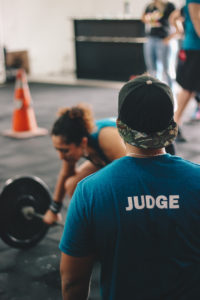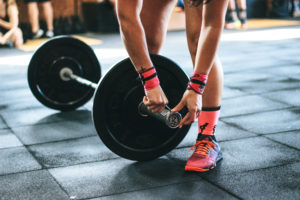In the past, a great deal of controversy surrounded the subject of resistance training among children and teens – especially with the prevalence of injuries in the competitive sports of weightlifting and power lifting.
But despite the long-held belief that strength training was dangerous or inappropriate for youngsters, the beneficial effects, as well as safety, of youth strength training are now well established. In fact, they have been documented in a number of publications. ,
Today, doctors, coaches, parents, and youth groups…
 are seeing these immense benefits for youth athletes, and resistance training is now being implemented as part of the physical education programs in many schools and institutions. At present, more than 3,000 teens are registered with the United States Power Lifting Federation, and 600 are members of the United States Weight Lifting Federation.
are seeing these immense benefits for youth athletes, and resistance training is now being implemented as part of the physical education programs in many schools and institutions. At present, more than 3,000 teens are registered with the United States Power Lifting Federation, and 600 are members of the United States Weight Lifting Federation.
These youth athletic groups are increasingly using strength training programs as a form of conditioning for participants in interscholastic sports, among both male and female athletes. The typical fundamental weightlifting exercises are employed in these training programs, including the deadlift and its many variations. Careful planning and supervision is key to the success of such a program, to ensure that there are few – if any – injuries among children and teen participants.
Several case studies…
have been carried out to evaluate the benefits and dangers of resistance training among youth athletes, particularly regarding weightlifting and power lifting. While available data is limited, there is indication that resistance training and weightlifting pose a significant risk of injury to teen participants when these exercises are performed improperly.
In one study published in Pediatrics, 98 musculoskeletal injuries were sustained by 71 teen (mean age of 16) weightlifters who participated in a weight training program for an average period of 17 months. These injuries resulted in a total of 1,126 days of discontinued training. This demonstrates the necessity for controlled and supervised training, and optimal instruction in the proper posture and procedure for performing such fundamental exercises as the deadlift and its variations, including snatches and cleans.
In fact, in several case studies, the primary causes of injury resulting from weight training were due to inappropriate coaching, unqualified instruction, or lack of qualified supervision. This resulted in poor exercise technique, and inappropriate or excessive weight loads.
While scores of studies have demonstrated that weightlifting can indeed be a safe and beneficial activity for children and adolescents, they have also demonstrated the need for qualified professional supervision during training sessions.
Proper preparation and posture when performing basic exercises is key…
to preventing injuries, particularly when performing moves such as the deadlift. The deadlift is one of the most basic and essential exercises in weightlifting, and the base for all other ground-based lifts in the sport, which means that mastering it is crucial.
 The deadlift and its variations represent an essential and foundational move in any strength-training regimen. The deadlift impacts trunk muscles and engages the entire body, developing strength in the trunk while exerting large amounts of force through the extremities. This exercise simultaneously engages motor units and muscle fibers, and promotes coordination as well as long-term resistance.
The deadlift and its variations represent an essential and foundational move in any strength-training regimen. The deadlift impacts trunk muscles and engages the entire body, developing strength in the trunk while exerting large amounts of force through the extremities. This exercise simultaneously engages motor units and muscle fibers, and promotes coordination as well as long-term resistance.
Because of its total-body impact and forceful engagement of key musculoskeletal systems, it is essential that the deadlift be performed correctly. When performed incorrectly, the deadlift and other major lifts have been shown to cause significant musculoskeletal injury. These injuries include ruptured or herniated disks in the spine, epiphyseal fractures, and bony disruptions in the lower back, as well as low back pain and muscle strain.
As more and more youth become interested in the sports and weightlifting, it becomes more important to ensure they are trained by properly qualified professionals and supervised appropriately during all training activities. This ensures that they reap the benefits of weight training rather than risking a preventable injury.
If you’re like most parents and coaches of youth athletes, then you’re probably deeply interested in safe, effective training options. It turns out there’s a new versatile, multi-purpose progression tool your youth athletes can use in the early stages of weight training, especially when deadlifting. It’s also a phenomenal tool for teaching young athletes safe and proper lifting techniques, allowing them to safely prepare for progression to the use of a standard barbell. [Click here for more information].
Robert Acuña Jr. is a Former 3 Time All-Conference College Offensive Lineman, Former All-Region College Offensive Lineman, Former Junior High & High School Coach and Creator of nextlevel.training
Falk B, Tenenbaum G: The effectiveness of resistance training in children: A meta-analysis. Sports Med 22:176-186, 1996.
Nielsen B, Nielsen K, Behrendt-Hansen M, et al: Training of “functional muscular strength” in girls 7-19 years old. In Berg K, Eriksson B (eds): Children and Exercise IX. Baltimore, University Park Press, 1980, pp 69-77.
American Academy of Pediatrics: Strength training, weight and power lifting, and bodybuilding by children and adolescents. Pediatrics. 86: 801-803, 1990.
Strength Training, Weight and Power Lifting, and Body Building by Children and Adolescents. Pediatrics 86:5, November 1990.
Gumbs VL, Segal D, Halligan JB, et al. Bilateral distal radius and ulnar fractures in adolescent weight lifters. Am J Sports Med. 1982; 10: 375-379.
Brown EW, Kimball RG. Medical history associated with adolescent powerlifting. Pediatrics. 1983; 72:636-644.
A D Faigenbaum1 and G D Myer Resistance training among young athletes: safety, efficacy and injury prevention effects Br J Sports Med. 2010 January; 44(1): 56–63.
Wenning, Matthew, MS, The Deadlift and Its Application to Overall Performance. The Journal of Strength and Conditioning Research. 26(3): 867-872, 2012.
Brady TA, Cahill BR, Bodnar LM. Weight training-related injuries in the high school athlete. Am J Sports Med. 1982; 10: 1-5.

7 thoughts on “Prevent Weightlifting Injuries In Athletes with Proper Training and Guidance”
Comments are closed.